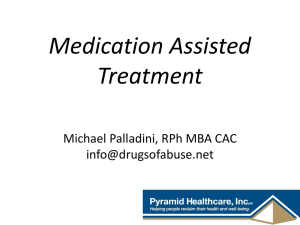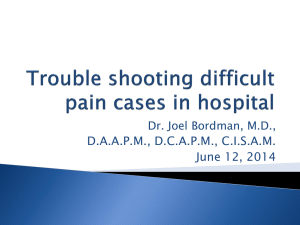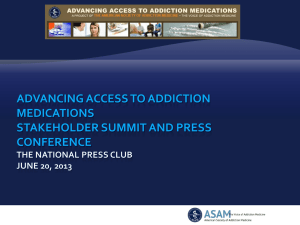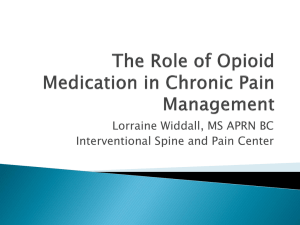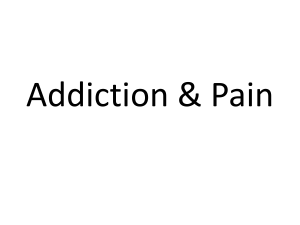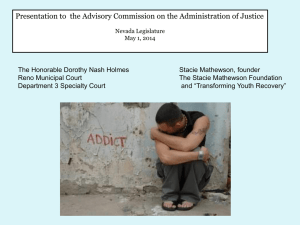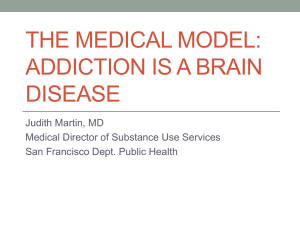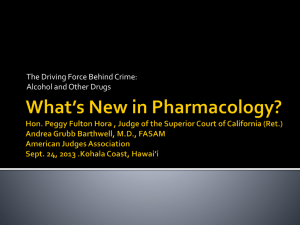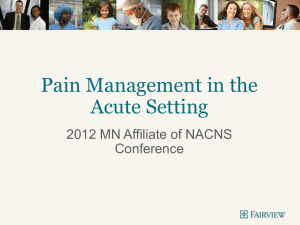Buprenorphine
advertisement
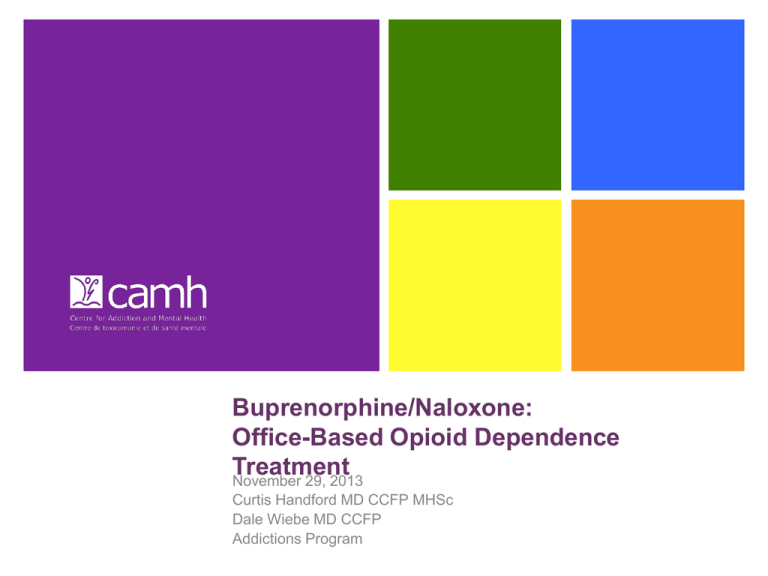
Buprenorphine/Naloxone: Office-Based Opioid Dependence Treatment November 29, 2013 Curtis Handford MD CCFP MHSc Dale Wiebe MD CCFP Addictions Program + Faculty/Presenter Disclosure • • • Faculty: Curtis Handford/Dale Wiebe Program: 51st Annual Scientific Assembly Relationships with commercial interests: – None 2 + Disclosure of Commercial Support • No commercial support of this program • Potential for conflict(s) of interest: None 3 + Mitigating Potential Bias • N/A 4 + Acknowledgements “Psychopharmacology of Opioids” Planning Group: DR. BERNARD LeFOLL MD, PhD, CCFP University of Toronto/CAMH DR. PETER SELBY MBBS, CCFP, FCFP, dip ABAM – University of Toronto/CAMH DR. MARILYN HERIE PHD, MSW, RSW University of Toronto/CAMH ROSA DRAGONETTI MA, CAMH WAYNE SKINNER MSW, University of Toronto/CAMH ANDREA TSANOS MA, CAMH CAMH Education Services: MS. GALIT KADIN MS. ANNE SIMON 5 Objectives By the end of the workshop you will be able to: List the benefits and describe pharmacology of buprenorphine/naloxone (Suboxone) Demonstrate the key elements of: Diagnosis Preparation Induction Maintenance + Cite the CAMH guideline (CPG) recommendations for the use of buprenorphine/naloxone. 6 + Agenda 130-140: Welcome and Introductions 140-200: Diagnosis 200-220: “Mary” video #1 and discussion 220-245: Treatment options and “Mary” video #2 245-315: Preparation and Induction 315-330: Break 330-400: “Darrell/Nancy” Induction Video and discussion 400-420: Maintenance/Take homes/Urine Tox 420-450: “Darrell/Nancy” take-home doses and discussion 450-500: Wrap up and evaluations 7 + Treatment Setting 8 + Buprenorphine in Primary Care France’s buprenorphine maintenance has largely been prescribed by primary care physicians. 1994-1999, access to opioid dependence treatment increased (bupe 80%, meth 20%) and overdose deaths decreased significantly (79%). Auriacombe et al. The American J on Addictions 2004;13:S17-28 Several studies demonstrate that buprenorphine can be used as effectively and safely in primary care when compared to specialty clinics. Gibson et al. Med J Australia 2003;179:38-4 O’Conner et. al. Am J Med 1998;105:100-105 9 + CPG Recommendation 2 Buprenorphine/naloxone maintenance treatment can be prescribed to patients in either a primary care setting or in a specialized addiction treatment setting. [I, A]. Intro p.12: “Advisable for a physician or pharmacist with no experience in opioid maintenance treatment to complete a formal program (examples: Appendix I) Drug monograph: Prescribers are to complete an “accredited Suboxone education program” CPSO: “buprenorphine prescribing course” + observe 10 + Diagnosis 11 + CPG Recommendation 3 •Prior to initiating maintenance opioid agonist treatment the patient should meet the diagnostic criteria for opioid dependence. [III, A] •Hard to interpret these DSM criteria in CNCP. Can be a challenging diagnosis to make in the chronic pain population. (Heit H and Gourlay D., 2009) •Canadian Opioid Guidelines are a resource to assist http://nationalpaincentre.mcmaster.ca/opioid/documents.html 12 + Case 1: Background Your patient of 5 years, John Doe, 25, arrives for an appt. one day and informs you he needs help for his addiction He has been buying MSContin® off the street for 18 months, “peeling” and injecting them. He now uses 4x100 mg tabs per day Flu-like symptoms if goes 12 hrs without 13 + Case 1: Background Spends all day worrying about how he is going to be able to get the money to pay for the pills Lost girlfriend, job, house Has tried to control his use, but he can’t seem to reduce his dose at all 14 + DSM-IV Tolerance: Yes Withdrawal: Yes Time Yes Spent: Unsuccessful Attempts Given Used Use to D/C: Yes up activities: ? more than intended: ? despite consequences: Yes 15 + Case 1: The Issue Diagnosis? Opioid dependence Plan? Withdrawal mgmt and intensive psychosocial treatment Buprenorphine/Naloxone Methadone 16 + Case 2: Background Your patient, Jane Frank, 53, has been prescribed codeine Contin® from you for the past 5 years to treat severe hip pain second to osteoarthritis Her pain scales are usually 3/10. She is able to work as receptionist and garden/golf. No previous evidence of misuse of prescription 17 + Case 2: Background Jane walks into the office and anxiously informs you that she had got stuck out of town for a day and ran out of her codeine. In that 24-hr period, she started to develop sneezing, generalized pain, nausea, sweats. This resolved after resuming codeine. She is frightened and wants to know if she is “addicted” to her codeine. 18 + DSM-IV Tolerance: Yes Withdrawal: Yes Time No Spent: Unsuccessful Attempts Given Used Use to D/C: No up activities: No more than intended: No despite consequences: No 19 + Case 2: The Issue Diagnosis? Physical What dependence do you advise her? No evidence of opioid dependence Physical dependence is an expected physiologic phenomenon. Does not equal addiction Next steps? Carry on Perhaps try a slow taper if patient really concerned 20 + Diagnosis: “Mary” Mary Video 2A: Q: Which criteria of the criteria listed in the DSM-IV have you identified in Mary’s history? 21 + Mary: DSM-IV Tolerance: Withdrawal: Time Spent: Unsuccessful Attempts Given Used Use to D/C: up activities: more than intended: despite consequences: 22 + Case 3: Mary Diagnosis? What Next do you advise her? steps? 23 + Prescribing Practices: Trial of Opioid Therapy in properly selected patients Check the “5 A’s” at every follow up visit (6-9 wks)7: Analgesic effectiveness (pain scales) Adverse Effects Ability to function Aberrant/Abuse behaviors (including substances) Affect If pain & function consistently improved at reasonable dose, can carry on without need for consultation. 24 + Prescribing: Aberrant Behavior High-risk abuse behaviors23,40: Many unsanctioned dose escalations Frequent lost prescriptions Concurrent abuse of related illicit drugs “Borrowing” drugs from others/street Injecting (tracks!), forgery, selling, doubledoctoring 25 + Prescribing: Aberrant Behavior Prevalence among chronic pain patients: 11.5% Illicit drugs present in 14.5% of UDSs No opioid or non-prescribed opioid in 20.4% of UDSs33 26 + Prescribing: Aberrant Behavior Grounds for action! “Lesser” behaviors should lead to more “structured opioid therapy (SOT)” Tightening of the boundaries, UDT, ?addiction medicine referral Watch for “pseudoaddiction”! Pseudoaddiction will ameliorate with SOT 27 + Diagnosing Opioid Dependence Tolerance, withdrawal in and of themselves do not equal “addiction” Acquiring significant amounts of opioids from other sources (other MDs, OTC, street) Injecting or insufflating prescribed opioids Failure to stabilize aberrant behavior with SOT If appropriate DSM IV-TR versus DSM V update OAT for moderate to severe? 28 + DSM IV-TR Dependence Tolerance Withdrawal Time Spent Unsuccessful attempts to D/C vs. Given up activities Used more than intended Use despite consequences Abuse Failure to fulfill major role obligations Use in hazardous situations Legal problems Social or interpersonal problems + DSM V Substance Use Disorder Tolerance (not counted if prescribed) Withdrawal (not counted if prescribed) Used more than intended Cravings Unsuccessful attempts to D/C Time Spent Given up activities Use despite consequences Failure to fulfill major role obligations Use in hazardous situations Social or interpersonal problems Mild 2 to 3 criteria Moderate 4 to 6 criteria Severe 7 to 11 criteria + Opioid Dependence Treatment Options 31 + Withdrawal Management (“Detox”) Evidence suggests that OAT outcomes superior to detox Can be hazardous on discharge due to loss of tolerance Most of OAT evidence from IV heroin users Reasonable, with informed consent, for some patients to attempt detoxification: Patient preference Exclusive Young PO opioid dependence age Brief duration of dependence Solid social supports 32 + Opioid Agonist Treatment [OAT] Observational studies demonstrate reduced mortality for individuals on OAT compared to those off OAT. (Gronbladh L et. al., 1990) (Caplehorn JRM et al., 1994) Reduced risky behaviour and decreased HIV seroconversion rates (Gowing et. al., 2008) (Metzger et al., 1993) 33 + Opioid Agonist Treatment Methadone and buprenorphine Meta-analyses for both drugs confirm superiority to placebo in terms of retention in treatment and reduced illicit opioid use Flex dose methadone appears marginally better in terms of treatment retention (RR 0.85, 0.73-0.98). Equivalent with respect to reducing illicit opioid use. (Mattick et. al., 2008) ? Old evidence generalizable to oral prescription opioid dependent pts 34 + Buprenorphine: Safety French population-level data 1994-1998 suggests that there is 3x less mortality due to buprenorphine than due to methadone. “46 rather than 288 deaths”. Auriacombe et al. JAMA 2001;285(1):45 Post-mortem studies also suggest lower rate of overdose deaths involving buprenorphine compared to methadone. Pirnay et al. Addiction 2004;99:978-988 Soyka et al. Pharmacopsychiatry 2006;39:85-87 Gibson et al. Drug and Alcohol Review 2007;26:405410 (?”underestimate of bupe deaths”) More OD symptoms with methadone than bupe Nielson 2007 and Nielson 2008 35 + Buprenorphine: Safety Bupe implicated in some OD deaths Almost exclusively (116/117) in combo with other sedating substances. Kintz et al. Forensic Science International 2001;121:65- 69. 7/43 bupe-alone deaths in UK 1980-2002 Schifano et al. Hum Psychopharmacol Clin Exp 2005;20:343-348 No difference in mortality b/w methadone and bupe gps (Ling 1996, Gibson 2008, Soyka & Apelt 2006*) Bupe more non-fatal heroin OD’s than methadone (P=0.08) DiGiusto 2004 36 + Pharmacology of buprenorphine 37 + Unique pharmacological properties High affinity for opioid receptor (i.e. binds tightly), thus blocking the effect of other opioids. Less risk of overdose and respiratory depression because it is a partial-agonist. Long half-life, thus allowing less-than-daily dispensing and possibly easier withdrawal. (Gowing L, Ali R, White J. 2006). 38 + Pharmacology: Safety Mu receptor – analgesia, respiratory depression, pupillary constriction, ↓bowel mobility, sedation Kappa receptor – analgesia, dysphoria, diuresis, ?addiction Mu receptor partial agonist (“turns partly on”) Ceiling effect for opioid agonist properties (Walsh SL et al. 1994) Full Agonist e.g. morphine Kappa receptor antagonist (“turns off”) Threshold for Fatal Respiratory Depression Could be what offsets the respiratory depression effect at higher doses May account for decreased dysphoria observed in some studies (Johnson et al, 2003) Opioid Effect Partial Agonist Dose of Opioid 39 + Route of Administration & Pharmacokinetics Available in Canada as sublingual tablet, takes a few minutes to dissolve. Film may be coming soon. Rapid absorption by buccal mucosa, then slowly released into bloodstream (45 min-1.5 hr) Peak plasma concentration in 1-4 hrs Very low oral bioavailability due to first pass effect Can be abused intravenously (reason for nlx) or intra-nasally (Chiang CN et. al., 2003. Walsh SLW, et. al., 2003) 40 + CPG Recommendation 10 Policy makers should be aware that in countries where buprenorphine is equally available as methadone, buprenorphine has a lower attributable death rate than methadone. [II-3, A] 41 CPG Recommendation 1 Once a patient is diagnosed with opioid dependence and is deemed appropriate for opioid agonist treatment, prescribers are encouraged to consider prescribing either buprenorphine/naloxone or methadone in order to increase retention in treatment and decrease opioid misuse. [I, A] + 42 CPG Recommendation 4 The decision to initiate opioid agonist therapy with either buprenorphine/naloxone or methadone maintenance should be guided by the individual clinical circumstances and the patient’s preferences. [III, I] + 43 CPG Recommendation 12 Buprenorphine/Naloxone may be preferred over methadone if… + C/I to methadone: allergy/QT risks (Level I) Hx of sexual S/E or oversedation on methadone (Level II) Increased risk of opioid toxicity (age, PMHx, BZ, meds (Level II)) Good prognostic factors (age, social, duration) Past success with buprenorphine Methadone unavailable in timely manner 44 Recommendation 13 Methadone may be preferred over buprenorphine/naloxone + Allergy to buprenorphine Pregnancy (buprenorphine/naloxone specifically) If induction withdrawal dangerous Hx injecting buprenorphine Prev inability to stabilize on buprenorphine Prev success with methadone Severe dry mouth No reliable way to pay 45 + Treatment Options: “Mary” Mary 2B: Q: Now that Mary expressed her interest in maintenance treatment with a long-acting opioid, which medication do you think may be better for Mary? Is there a specific reason to choose one over the other? 46 + Using Buprenorphine/naloxone 47 + CPG Recommendation 6 Prior to initiation of buprenorphine/naloxone treatment, the patient must provide informed consent and there must be physician documentation that the patient has been informed of the physical dependence on the medication and possible long-term nature of the maintenance treatment. [III A] 48 + Buprenorphine-Preparation Diagnosis Urine of opioid dependence Drug Test (UDT) positive for opioids (Sup 4) Contraindications? Informed consent Treatment options Risks and benefits Clarify goals and expectations Establish coverage Consider written treatment agreement (Appendix J) 49 + Bup/Nlx Contraindications Pregnancy (buprenorphine/naloxone specifically) Allergy Severe Acute liver dysfunction severe respiratory illness Decreased Paralytic Inability level of consciousness ileus to provide informed consent Possibly elevated transaminases beyond 3-5 times ULN 50 + Preparation Investigations: βHCG Liver enzymes/LFTs HIV/Hepatitis testing Instructions for induction day: Present in withdrawal D/C IR opioids 12+ hrs, SR opioids 24+ hrs Do not drive 51 + Formulary coverage As of October 30, 2012, Suboxone is Limited Use in Ontario: LU code 437: Failed methadone Intolerance Contraindication (ie QT, allergy) Higher risk for opioid toxicity BZ, alcohol, p450 inhibitors, elderly, lower tolerance LU code 438: methadone maintenance program is not available or accessible >3 mos 52 Induction + 53 CPG Recommendation 5 A physician should have a structured approach, such as the one suggested in the clinical considerations, to initiating buprenorphine/naloxone maintenance treatment in order to stabilize a patient at their maintenance dose as rapidly as possible while at the same time avoiding oversedation or precipitated withdrawal. [III, A] + 54 Buprenorphine - Induction Patient must be in moderate opioid withdrawal before receiving the initial dose of bup/nlx Estimated Short-acting opioids: 6h minimum, 12h preferable E.g. heroin, oxycodone, hydromorphone, codeine Longer-acting opioids: 12h minimum, 24h preferable + amount of time to wait after last use: OxyContin® and other slow-release opioids that are chewed or crushed; longer if swallowed whole Methadone: 24h minimum, 36h – 3 days preferable 55 Buprenorphine - Induction Suggest 2 + use COWS assessment tool (Appendix K) If score <13 (mild withdrawal), advisable to wait until next day or reassess in 2-4 hours If ≥13, initiate dosing mg dose if at higher risk for opioid toxicity not completely certain the patient is in moderate withdrawal transferring from methadone 4 mg for patients clearly in withdrawal & at lower risk for opioid toxicity COWS=Clinical Opiate Withdrawal Scale 56 Buprenorphine-Induction Consider reassessment at 1hr to assess for precipitated withdrawal (p/w). If p/w, do not give an additional dose of buprenorphine/naloxone Consider reassessment at 3hrs to assess need for additional dose(s). Can + provide additional 2mg doses on day # 1 (to a max of 8mg on day 1). Observed or take-home Return to clinic next 1-3 days for possible dose increase. 57 Precipitated Withdrawal – What Is It? Buprenorphine preferentially binds to the opioid receptor, but only partially activates it Abrupt onset of withdrawal symptoms within 1 hour of taking buprenorphine dose; sxs peak 1.5-3hrs May take up to 12 hours to resolve + Management is symptomatic Additional doses will worsen symptoms 58 Precipitated Withdrawal mu opioid receptor buprenorphine opioid Precipitated Withdrawal dopamine Intoxication Significant amount of opioid bound to receptors “Volume” on max Buprenorphine Binds preferentially to receptors “Volume” on medium Relative to intoxication, Suboxone® “turns on” receptors less patient feels withdrawal Induction + Withdrawal Most receptors unbound “Volume” on low Buprenorphine Binds preferentially to receptors “Volume” on medium 59 Relative to withdrawal, Suboxone® “turns on” receptors more patient feels better + Induction: “Darrell” Q: How would you define the state of Darrell’s withdrawal? How do you suggest to proceed: Q: How could this have been prevented? 60 Buprenorphine - Titrating dose Dose Maximum recommended daily dose 24 mg (according to Canadian Product Monograph) Dose can be increased daily or every 2-3 days by 2-4 mg Average maintenance dose range 8-12 mg/day + 61 Induction Faster induction=better retention (Compton P et al. 1996) (Doran C et al. 2005) Monitor for opioid toxicity Collateral Induction + hx valuable if available is a balance between: Buprenorphine’s dynamics: “Ceiling” effect of partial agonist Buprenorphine’s kinetics: Long half-life of 24-36 hrs 62 Induction Maintenance dose should be reached within a couple of weeks: No opioid withdrawal symptoms for 24hrs Reduction in cravings No reinforcing effect from opioids + 63 + Induction: “Nancy” Q: What is your interpretation of Nancy’s disclosure? How would you like to respond? Q: Based on the information Nancy has thus far provided, will you increase her bup/nlx dose? By how much? For how many days will you prescribe the new dose? Q: Would you increase the dose at this point? How much? 64 65 66 67 68 + Take-home doses 69 + CPG Recommendation 9 In making decisions regarding the provision of take-home doses of buprenorphine/naloxone, providers should use a clinical risk stratification strategy (as described in the clinical considerations) that aims to support patient autonomy while at the same time respecting patient and public safety. [III, A] 70 + Buprenorphine/Nlx - Take-home doses Health Require buprenorphine be prescribed daily observed for 2 months, except for weekends and holidays (if pharmacy closed) No evidence identified supporting this for buprenorphine/naloxone When Canada & Product Monograph: deciding about take-home doses assess: Is it safe for the patient? Is it safe for the public? What is the risk of diversion? 71 + Take-home doses Early in treatment 3 categories: Too unstable to have any take-homes, including weekends and holidays 1. Recent IV drug use Recent suicidal ideation Significant cognitive impairment Unstable housing Ongoing opioid use Other active alcohol or drug dependencies “Concern NYD” 72 + Take-home doses Early in treatment 3 categories: Appropriate to provide “weekend and holiday” take-homes: 2. No recent IV drug use No recent suicidality No signifiant cognitive impairment Stable housing Achieved abstinence from opioids No other active alcohol or drug dependencies No “concern NYD” 73 + Take-home doses Early in treatment 3 categories: Appropriate accelerated take-home doses beyond “weekends and holidays” within the first 2 months: 3. Clinical stability beyond category 2: No significant psychiatric co-morbidity Particularly stable social situation Overly restrictive take-home dosing may lead to treatment drop out due to work conflicts. 74 + Take-home doses If providing accelerated take homes: Consider other options first EOD dosing, pharmacy change Discuss with the patient the risks of these “accelerated” take-homes Monitor closely to ensure benefit Document carefully 75 + Take-home doses Number of take-home doses per week increases gradually Suggested maximum of 6-13 consecutive takehome doses, dispensed between observed doses. If relapse to problematic drug use or compromised clinical stability: More frequent visits and UDS Increased number of witnessed doses 76 + Take-Home Doses: “Darrell” and “Nancy” Q: Are there any circumstance under which you will consider to give takehome doses during the first week of treatment with buprenorphine? Q: What do you want to do with her bup/nlx treatment? Q: What do we look for to determine “clinical stability”? Q: When would you consider re-instituting take home doses? 77 + Take-home doses: Safety Injection abuse: Plenty of evidence that buprenorphine monoproduct is injected (Obadia 2001, Vidal-Trecan 2003). Much more than methadone (Barrau 2001). Evidence that bup/nlx is pleasurable to non-dependent users (Strain 2000, Weinhold 1992) IV Bup/nlx pleasurable in bup/nlx maintained subjects (Bell 2007) Case reports of hepatotoxicity if abused IV (Herve 2004) 78 + Buprenorphine/Naloxone: Injection Naloxone was introduced to deter IV use Naloxone: opioid receptor antagonist binds opioid receptor, but no intrinsic activity precipitates withdrawal in clients physically dependent on opioids little to no sublingual or oral bioavailability deterrent only when used IV (Chiang, NC, 2003.) 79 + Buprenorphine/Naloxone: Injection But naloxone… only partially blocks opioid receptor binding has much shorter duration of action than buprenorphine Combo product is abused despite “deterrent effect” 80 + Missed doses 81 + Buprenorphine - Missed doses Missed ≤ 5 days may resume their usual dose Missed > 5 consecutive days MD should reassess before restarting New dose can be titrated upwards by 2-4 mg/day Usual dose Number of consecutive days missed New starting dose > 8 mg > 7 days 4 mg > 8 mg 6-7 days 8 mg 6-8 mg 6 or more days 4 mg 2-4 mg 6 or more days 2-4 mg Lintzeris et. al. Commonwealth of Australia, 2006 82 + Urine Drug Testing (UDT) CPG Recommendation 8: When monitoring a patient on buprenorphine/naloxone maintenance, the physician should adopt a patient–centred urine drug testing strategy that maximizes clinical utility while avoiding testing without indication. [III, I] Guideline Supplement 4 OAML March/Aug 2013 Memos (Handouts) On-line urine toxicology resource: http://www.udtmonograph.com/ 83 84 http://www.udtmonograph.com/ + Urine toxicology Enzyme immunoassay (EIA) Lab or point-of-care (PoC) Quick results Sensitive, not specific Mostly classes of drugs Window 3-5 days most substances Chromatography (GC/MS or LC/MS) Lab only Slower results Specific Individual substances Shorter window of detection (1-3 days) 85 + Urine toxicology Ordering “Drugs with Community Labs: of Abuse Screen” EIA opioids, “Broad cocaine, BZ, barbs, THC spectrum urine toxicology” Chromatography Since Sep 2013: LC/MS/MS “Please look for….” 86 87 c/o Gamma Dynacare 88 c/o Gamma Dynacare + Urine toxicology Not as straightforward as it might seem! Opiate EIA Natural Opiates (ie morphine) Semi-synthetic (ie oxycodone) Synthetic (ie fentanyl) Cross-reactions Cut-offs Supervised collection/temp. testing Dilute samples Call the lab if unexpected result! 89 + Opioid Maintenance Tapering Long term treatment, so almost always patientdriven. Principles of support during taper: Frequent clinic visits Supportive counseling Pace of the taper determined by client except in rare cases of involuntary discharge. Clonidine, NSAIDs, loperamide as adjuncts near end of taper. 90 + Buprenorphine Tapering Withdrawal may be less prolonged and severe than for methadone Maybe Taper delayed in onset slowly (e.g. 2mg per week) 91 + Opioid Maintenance Tapering (cont’d) Put taper on hold or increase dose if: severe withdrawal symptoms drug cravings drug use “Detoxification fear”: client may be fearful of life without safety net of medication and program support, especially near end of taper Important to offer support post-taper and facilitate return to opioid maintenance treatment if relapse 92 + Buprenorphine Overdose Signs: sedation, hypotension, pinpoint pupils, respiratory depression Low risk overdose unless combined with other CNS depressants Medical emergency – need hospital monitoring Primary management should be protection of airway Naloxone may not be effective higher doses than usual recommended to increase the probability that naloxone will preferentially bind opioid receptor vs. buprenorphine 93 + Summary Buprenorphine/naloxone is an evidence-based maintenance treatment for opioid dependence Evidence for efficacy and safety in primary care settings Partial mu properties reduces overdose risk Office-based physicians can: Diagnose Induct Maintain Take-home doses are contingent on clinical stability Urine drug testing is an important aspect of this work 94 + Resources 1. 2. CAMH Bup/Nlx on-line course (early ‘14) CAMH ODT core course: Jan 9-Feb 9/14 Feb 15-Mar 15/14 Mar 27-Apr 27/14 3. Addiction Medicine Service at CAMH 1. Self-refer: 416-535-8501 x 36019 2. CAMH MD Referral F: 416-595-6821 4. Addiction Clinical Consult Service (ACCS): Tel: 416 595-6968 or toll free 1 888 720-2227. Hours: 8:00 a.m. to 4:00 p.m., Monday to Friday. 95 Reference: + Auriacombe, M., Franques, P., & Tignol, J. (2001). Deaths attributable to methadone vs buprenorphine in france. JAMA, 285(1), 45 Barrau, Karine; Thirion, Xavier; Micallef, Joëlle; Chuniaud-Louche, Christine; Bellemin, Béatrice; et. al. (2001). Comparison of methadone and high dosage buprenorphine users in French care centres. Addiction, 96(10), 1433–1441. Bell, J., Shanahan, M., Mutch, C., Rea, F., Ryan, A., Batey, R., et al. (2007). A randomized trial of effectiveness and cost-effectiveness of observed versus unobserved administration of buprenorphine-naloxone for heroin dependence Addiction (102)12, 1899–1899. Bridge, TP et. al., 2003. Safety and health policy considerations related to the use of buprenorphine/naloxone as an office-based treatment for opiate. Dependence. Drug and Alcohol Dependence. 70; S79-S85. Caplehorn JRM, Dalton MYNS, Haldar F, Petrenas A, Nisbet JG. Methadone maintenance and addicts’ risk of fatal heroin overdose. Substance Use and Misuse. 1996;31(2):177196. Chiang, CN, et al., 2003. Pharmacokinetics of the combination tablet of buprenorphine and naloxone. Drug and Alcohol Dependence, 70: p. S39-S47. Compton PA, Wesson DR, Charuvastra VC, Ling W. Buprenorphine as a pharmacotherapy for opiate addiction: what dose provides a therapeutic response? American Journal on Addictions. 1996;5(3):220-230. Doran C, Holmes J, et al. Buprenorphine induction and stabilization in the treatment of opioid dependence. Heroin Addiction and Related Clinical Problems. 2005;7(1):7-18. Gowing L, Ali R, White J. Buprenorphine for the management of opioid withdrawal. Cochrane Database Syst Rev. 2006 Apr 19;(2):CD002025 96 Reference: . L. Grönbladh*, L. S. Öhlund, L. M. Gunne. Mortality in heroin addiction: impact of methadone treatment Acta Psychiatr Scand 1990;82:223 Heit H and Gourlay D. DSM-V and the definitions: Time to get it right. Pain Medicine 2009;10(5):784-786. + Herve, S., Riachi, G., Noblet, C., Guillement, N., Tanasescu, S., Goria, O., et al. (2004). Acute hepatitis due to buprenorphine administration. European Journal of Gastroenterology & Hepatology, 16(10), 1033-1037. Johnson et al., Buprenorphine: how to use it right. Drug and Alcohol Dependence 70 (2003) S59-S77 Kintz, P., 2001. Deaths involving buprenorphine: a compendium of French cases. Forensic Sci. Int. 121, 65-69. Mattick RP, et al., Buprenorphine maintenance versus placebo or methadone maintenance for opioid dependence. Cochrane Database of Systematic Reviews 2008, Issue 2. Metzger DS, Woody GE, McLellan AT, O’Brien CP, Druley P, Navaline H, et al. Human immunodeficiency virus seroconversion among intravenous drug users in- and out-oftreatment: an 18-month prospective follow-up. Journal of Acquired Immune Deficiency Syndromes. 1993;6(9):1049-1056. Nielsen, S., Dietze, P., Lee, N., Dunlop, A. and Taylor, D. (2007). Concurrent buprenorphine and benzodiazepines use and self-reported opioid toxicity in opioid substitution treatment. Addiction (102)4, 616-622. 97 Reference: + Obadia Y, Perrin V, Feroni I, Vlahov D, Moatti JP. Injecting misuse of buprenorphine among French drug users. Addiction. 2001;96(2):267-272. Pirnay, S., Borron, S. W., Giudicelli, C. P., Tourneau, J., Baud, F. J., & Ricordel, I. (2004). A critical review of the causes of death among postmortem toxicological investigations: Analysis of 34 buprenorphine-associated and 35 methadone-associated deaths. Addiction, 99(8), 978-978 Raynaud M et al. Six deaths linked to concomitant use of buprenorphine and benzodiazepines. Addiction 1998;93(9):1385-1392. Sharon L. Walsh, SLW, et. al., a, 2003. The clinical pharmacology of buprenorphine: extrapolating from the laboratory to the clinic. Drug and Alcohol Dependence 70; S13-S27. Strain, E. C., Stoller, K., Walsh, S. L., & Bigelow, G. E. (2000). Effects of buprenorphine versus buprenorphine/naloxone tablets in nondependent opioid abusers. Psychopharmacology (Berl.), 148(4), 374-383. Vidal-Trecan G, Varescon I, Nabet N, Boissonnas A. Intravenous use of prescribed sublingual buprenorphine tablets by drug users receiving maintenance therapy in France. Drug and Alcohol Dependence. 2003;69 :175-181 Walsh SL et al. Clinical pharmacology of buprenorphine: ceiling effects at high doses. Clinical Pharmacology and Therapeutics 1994;55:569-80. Weinhold, L. L., Preston, K. L., Farre, M., & Liebson, I. A. (1992). Buprenorphine alone and in combination with naloxone in non-dependent humans. Drug & Alcohol Dependence 30(3), 263-263. Suboxone® product monograph. www.epocratesonline.com. 98
